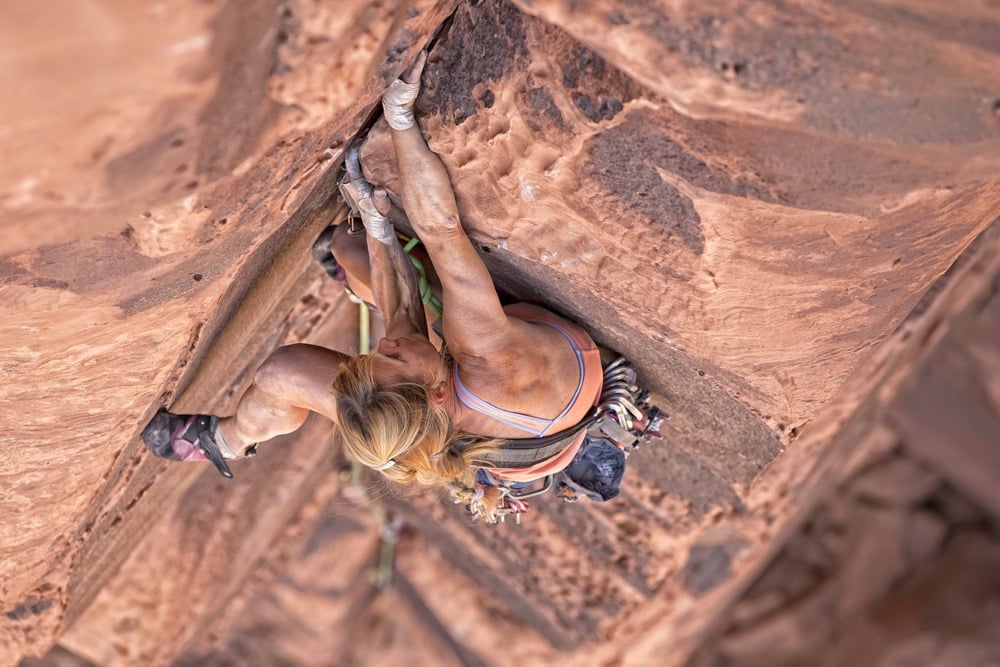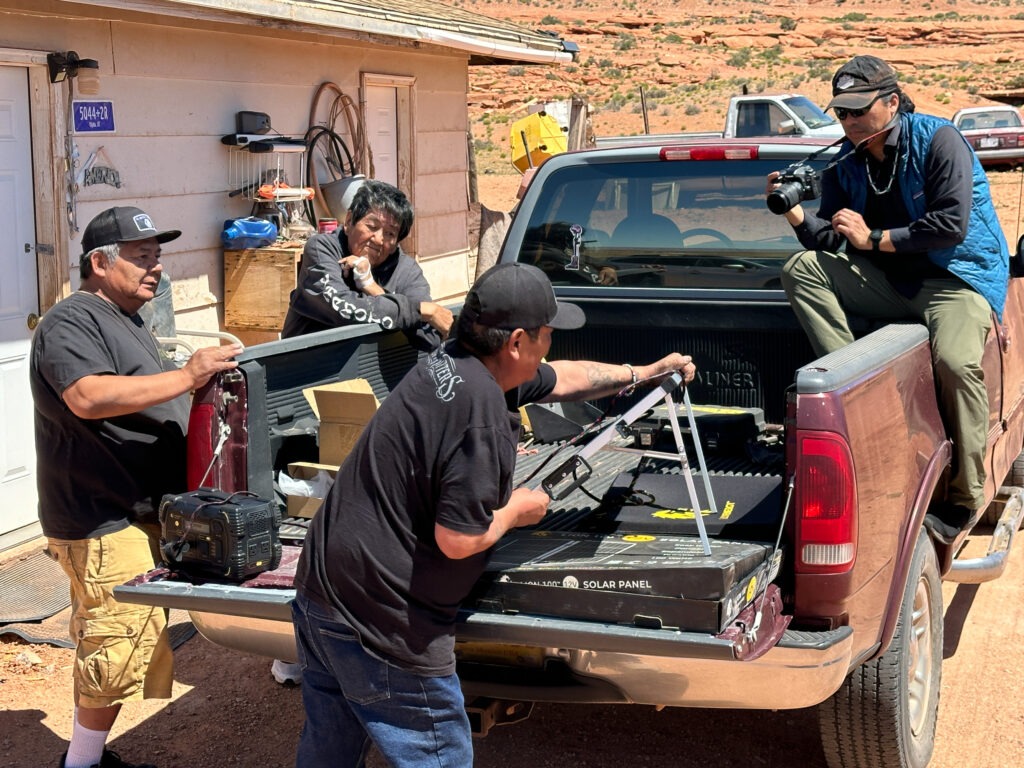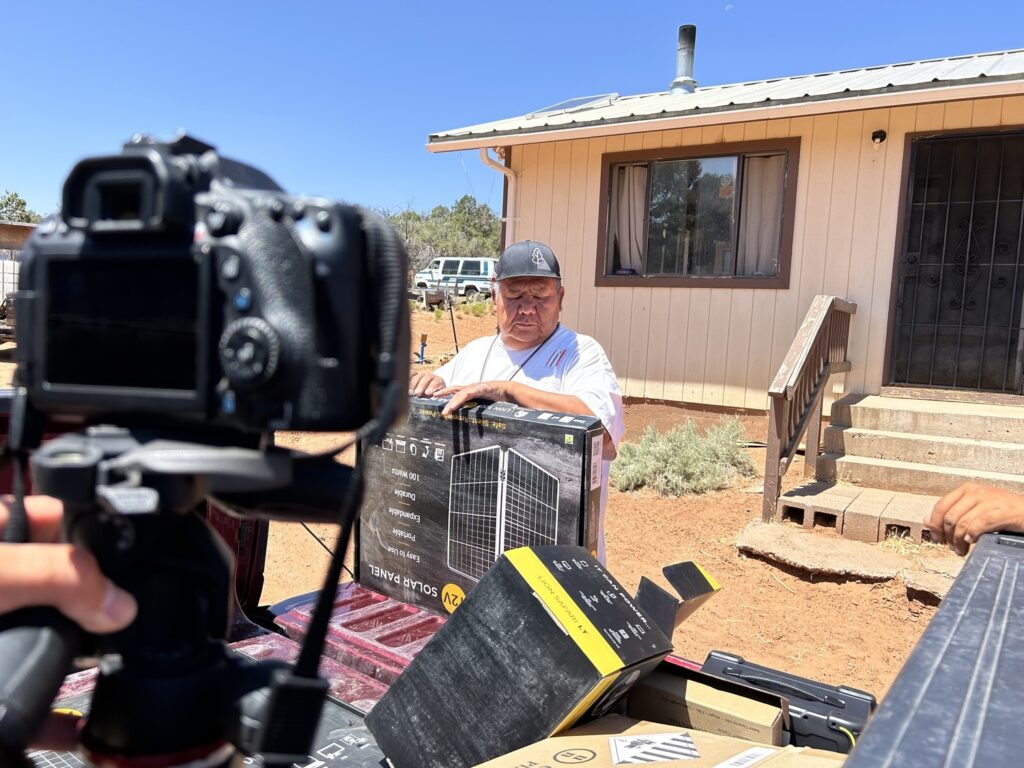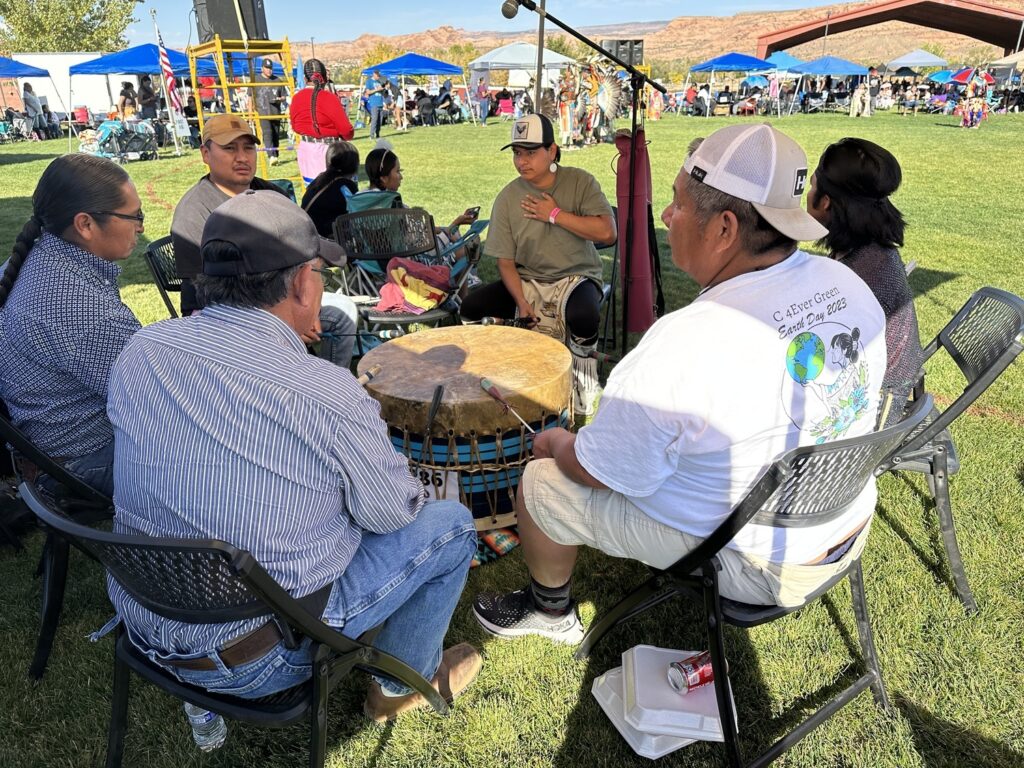Navajo Solar Sunrise: A Story of Indigenous-Led Solutions, Community Power, and Climate Justice.
Photos courtesy of Kitty Calhoun and Angelo Baca
When POW Athlete and Climb Alliance Member Kitty Calhoun set out to bring solar energy to the Navajo Nation, she quickly realized that this wasn’t her story to tell. This is a story that can only be told by Indigenous voices.
“This is a multi-faceted topic, and I can only speak as an ally,” says Calhoun, an alpinist whose love for remote mountains led her to a lifelong connection with the land and its original stewards. “I haven’t walked in their shoes. The film is their story. All I can do is talk about my experience as an ally and how this project came to be.”

The idea took shape at a climate summit in 2023. Kitty struck up a conversation with representatives from Lion Energy, a Utah-based battery company working to get power to villages impacted by the war in Ukraine. “I mentioned Indigenous people closer to home in Bears Ears, and their eyes lit up,” Kitty recalls. “What if we brought solar kits to remote homes here in the Southwest?”
She soon secured 100 solar battery kits—which included 12V and 24V solar panels and the LED light string—and began thinking about how to distribute them to Navajo families living without reliable access to electricity. Then came a pivotal realization. One that changed the project’s direction and deepened her role as an ally.
“I was reading Carbon Sovereignty, a book about energy development on the Navajo Nation, and it finally hit me,” she says. “Colonialism isn’t a one-time land grab, but continues today through subtle and not-so-subtle forms. That’s when I realized that only an Indigenous person could tell this story.”
That person was Angelo Baca, and Emmy-winning filmmaker Sahar Khadjenoury.
Angelo, an Indigenous filmmaker, scholar, and community advocate, had already spent years working on the front lines of public land protection and cultural preservation in the Bears Ears region. As a Navajo (Diné) and Hopi Nations member and a relative of the very families receiving solar kits, he was the natural choice to direct the film.
And for Sahar, this story is deeply personal. “I’m from Aneth, Utah—a place deeply etched into my identity as both Navajo and Persian,” she says. “This is my home community, and it’s where I spent my early years living with my grandmother in a home without electricity or running water.”
The Need For Renewable Energy
In the high desert of the Navajo Nation, access to electricity remains a daily struggle. Roughly 30% of Navajo households—around 13,000 to 15,000 homes—still live without power. Families rely on gas generators and makeshift battery setups that pose serious fire risks or go without entirely.

Navajo Solar Sunrise is working to flip the switch on a different kind of future: one powered by relationships, renewable energy, and deep respect for culture and land.
“We weren’t trying to do an altruistic, feel-good action or make a movie for ourselves,” says Angelo. “We’re invested in this community. We wanted to tell a story that honored the people who live this reality every day.”
For both Angelo and Sahar, their connection to the community deepened during the pandemic as they delivered food and PPE across the Utah Navajo Nation. “Through that work, I truly regrounded myself and realized the profound impact that a lack of electricity has, especially on our elders who need additional help or care,” says Sahar. “It’s not just about convenience; it’s about basic human dignity and health. Imagine not being able to properly store life-saving insulin for those with diabetes, or power an oxygen machine, or even just an electric blanket during our harsh winters”.
Stories like a widowed mother running a household off one gas generator or an elder who froze to death after running out of firewood made the work urgent. “This shouldn’t be happening in the United States,” says Kitty.
Bringing Solar to the Navajo Nation
The Navajo Solar Sunrise team—Angelo, Kitty, Sahar, community organizer Norman Lameman, and the Public Health team at Utah Navajo Health System—delivered the 100 solar kits. But it was never just about technology. It was about trust, accountability, and care.

“We weren’t just dropping off kits and leaving,” Angelo explains. “We went in with the people we know, being transparent about our clans and our purpose. We’re accountable to the community, not just the project.”
The kits are simple but transformative: portable battery packs that power essentials like lights, phones, and small appliances. In a place where electricity isn’t guaranteed, the impact is immediate. “One veteran had a battery with burn marks on the wall,” Angelo recalls. “We came just in time. He could’ve lost his house.”
For Sahar, the response has been overwhelmingly positive and filled with quiet triumph. “I’ve seen how something as simple as a light bulb or a charged phone can change lives,” she shares.
Still, barriers remain. Many haven’t had access to reliable infrastructure or clear information. People are skeptical, and rightfully so. “It really comes down to trust—who introduces the idea, and whether that person is known in the community. Some folks open up because they know Norman or Sahar,” Angelo explains.
And once that trust is earned, something shifts.
“You see people plugging in lights, charging phones—it’s incredible,” Angelo says. “At one event, they even started talking about linking kits together to create a mini-grid.”

Ultimately, the impact is both practical and profound. “The most rewarding aspect is witnessing the immediate improvement in quality of life and the surge in self-reliance. It’s seeing an elder able to safely store insulin, or a child being able to do homework after dark,” Sahar says. “It’s the empowerment that comes from knowing you have control over your own power source, rather than being beholden to distant grids or expensive, unreliable alternatives. It reinforces our traditional values of self-sufficiency and caring for one another.”
Climate & Extractive Industry’s Impact on Frontline Communities
Climate change isn’t a distant threat for Indigenous communities like Angelo and Sahar’s—it’s already here.
“The ecosystems are receding, the water tables are drying up, animals and plants are migrating, the seasons are becoming unnatural, and our crops are harder to grow. This is a matter of survival,” Angelo says.
But the damage isn’t just environmental, it’s cultural, too.“How can we practice our cultural, spiritual, and ceremonial traditions if our connection to the land is broken?” he asks. “My community is impacted by drought, lack of water, and mining because people see this as just an empty desert. They don’t care what happens here.”
For decades, extractive industries have treated Indigenous lands as sacrifice zones. And now, new threats are mounting. Utah is becoming a hub for nuclear energy development, with new facilities on the horizon and the nation’s only operating uranium mill—White Mesa—just a mile outside Bears Ears National Monument. The mill processes uranium and other “critical minerals,” signaling a new chapter of resource extraction in the West that disproportionately impacts Navajo and other frontline communities.

“There are hundreds of abandoned, unremediated uranium mines on the Navajo Nation,” Angelo says. “They haven’t learned their lesson. Once you destroy a place—especially with nuclear contamination—it stays poisoned for generations. In the air, in the water, in the soil.”
These are not abstract fears. “I’ve already seen what it does to people,” he continues. “There’s nothing you can do for those poisoned by uranium. They die slow, painful deaths while everyone else gets to ignore it.”
Sahar also sees these impacts daily. “On the Navajo Nation, we face a complex interplay of climate challenges exacerbated by infrastructure gaps,” she explains. “While many think of large-scale environmental disasters, for us, it’s often the subtle, relentless impacts: increased heat during already scorching summers, prolonged droughts affecting our water resources, and the unpredictability of severe winter storms that can isolate communities for days.”
That’s why renewable energy isn’t just about innovation, it’s about survival.
“Renewable energy, particularly solar, offers a transformative solution,” Sahar says. “Beyond simply providing light, it’s about energy independence and resilience. Solar panels on homes mean elders can store their medication safely, power essential medical equipment, and stay warm in the winter without relying on dangerous alternatives.”
And it’s a solution rooted in culture, not imposed from the outside world.
“It reduces our carbon footprint, aligns with traditional values of living in harmony with the land, and eases the burden of high energy costs,” Sahar continues. “It’s a direct response to climate challenges that empowers our communities at the most fundamental level.”

For Angelo, the choice is clear: “We’re not willing to return to coal and uranium—especially nuclear. It’s not in alignment with Indigenous values, let alone Navajo ones. Solar isn’t the whole answer, but it’s a stepping stone. A future where we can thrive without poisoning our land or our people—that’s worth fighting for.”
Connecting Non-Native and Native Audiences
Navajo Solar Sunrise offers more than just inspiration. It’s a story about respect and reciprocity. Building that kind of relationship takes work. For filmmaker Angelo Baca, it’s been a lifelong commitment.
“It’s been my life’s work to educate across cultural, linguistic, and educational lines,” Angelo explains. “We have to learn about each other, what our values are, what our cultures are like, and where we prioritize certain things.” He points out how rare it is for Native communities and outdoor recreation groups like Kitty’s to truly connect, even while sharing the same landscapes. “We’re in the same space all the time, but we don’t always talk or make contact. How are we supposed to build real relationships without opening up those lines of communication?”

Sahar hopes non-Native viewers walk away with more than awareness of the disproportionate climate impacts Indigenous communities face, but also a deeper respect for their strength and vision. “These aren’t just niche projects, but vital models for sustainable living and climate resilience for everyone,” she says. “It’s about shifting the narrative from charity to true partnership and respect for Indigenous sovereignty and expertise.”
And for Native audiences, she hopes the film offers affirmation. “It shows what’s possible when we leverage our traditional knowledge and modern technology to build a resilient future on our own terms,” Sahar continues. “It’s a testament to the power of community action and a reminder that we have the wisdom and capacity to lead the way in addressing climate change from within our own territories.”
Watch Navajo Solar Sunrise Now:
Want to get involved? Here are a few ways to take the next step:
That invitation to build bridges, learn, and show up with respect doesn’t end when the credits roll. It starts there.
Get informed by learning directly from Indigenous voices:
- Read Carbon Sovereignty and follow Indigenous authors like Len Necefer on Substack.
- Watch Demon Mineral, an Indigenous-made film on the impacts of uranium mining, and stream First Nations Experience (FNX), a PBS affiliate showcasing Indigenous stories.
- Support filmmakers like Angelo Baca and Sahar Khadjenoury, whose work centers on Indigenous perspectives.
Support Indigenous-led solutions by donating to sharing the work of:
- C4evergreen is a nonprofit focused on clean energy, water, and waste management.
- Utah Navajo Health System provides culturally grounded health care for the Navajo Nation.
Say no to Uranium mining: The Navajo Nation strongly opposes uranium mining on its land due to the historical and ongoing negative impacts on the health and environment of the Navajo people. They have banned uranium mining within their reservation and actively oppose the transportation of uranium ore across their lands, citing concerns about contamination and the legacy of past mining operations. Some Non-profits to support include:
- Haul No fights against the transportation of uranium through Indigenous lands, especially the Pinon Plain Mine and White Mesa Mill.
- Dine Citizens Against Ruining Our Environment ( Dine CARES) advocates for the protection of Dine land, water, air, and culture and works to challenge harmful extraction industries.
- Multicultural Alliance for Safe Environment (MASE) unites grassroots organizations to address lingering impacts of uranium mining, advocating for cleanup and accountability.
Join the movement.
Organizations like POW and Third Act work at the intersection of climate, justice, and community. Support their work and get involved in local action.
If we care about the same places, it makes sense to learn from and stand with the people who have been protecting them for generations. That means taking action in big and small ways, like buying from outdoor brands such as Patagonia that align with your values, and using your voice by supporting the Native American Voting Rights Act and showing up to vote.

Author: Stacie Sullivan
Stacie always knew she wanted to pursue a career in the ski industry from a young age, having first clicked into skis at the age of 4 and writing her 8th grade career project on being a professional skier. While her dreams of becoming a professional athlete didn’t quite pan out the way she planned at […]
